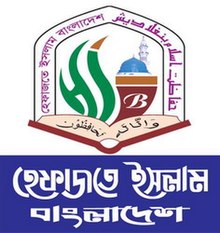Hefajat-e-Islam Bangladesh

The logo of Hefajat-e-Islam Bangladesh
|
|
| Formation | January 2010 |
|---|---|
| Type | Islamic revivalism, Islamic fundamentalism |
| Headquarters | Hathazari, Chittagong, Bangladesh |
|
Region served
|
Bangladesh |
|
Official language
|
Bangla |
|
Amir
|
Ahmad Shafi |
Hefazat-e-Islam Bangladesh (Bengali: হেফাজতে ইসলাম বাংলাদেশ;) or Hifazat-e-Islam Bangladesh is an Islamist pressure group of madrassah teachers and students. In 2013, it submitted to the government of Bangladesh a 13-point charter, which included the demand for the enactment of a blasphemy law.
Hefazat-e-Islam was formed in 2010, as a pressure group comprising the teachers of several madrasas at Chittagong, Bangladesh. The formation was allegedly triggered by the 2009 "Women Development Policy" draft. On February 24, 2010, Hefazat wanted to hold a rally at Laldighi Maidan, Chittagong to protest the government's move to slap a ban on religion-based politics, cancellation of the Fifth Amendment to the Constitution, and a proposed education policy that would have ended madrasah education. The police refused their request to hold a rally and injured 19 protesters. A few of these madrasa students were arrested by police and later released. In 2011, Hefajat-e-Islam protested some aspects of the proposed Women Development Policy.
Ahmad Shafi, the director of Hathazari Madrasa and Mufti Izharul Islam, the chairman of the Islamist party Islami Oikya Jote, are regarded as the founders of Hefazat-e-Islam.
In 2013 Hefajat-e-Islam was reformed after the allegation that some of the protesters in the Shahbag protests, were involved in publishing of content offensive to Muslims on blogs, including the depiction of Muhammad as a pornographic character. They arranged a rally towards capital city Dhaka, demanding enaction of capital punishment of the "atheist bloggers" involved in the Shahbag movement and a blasphemy law.
...
Wikipedia
